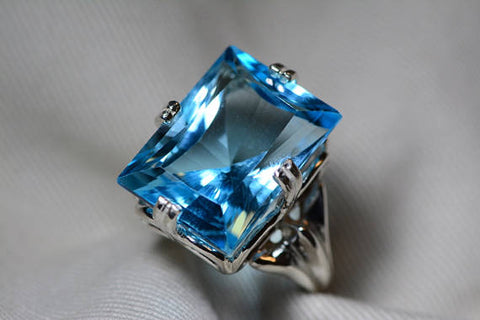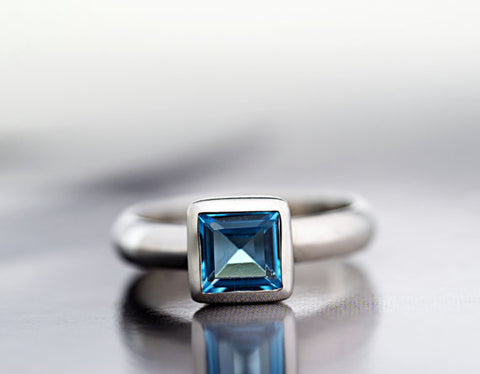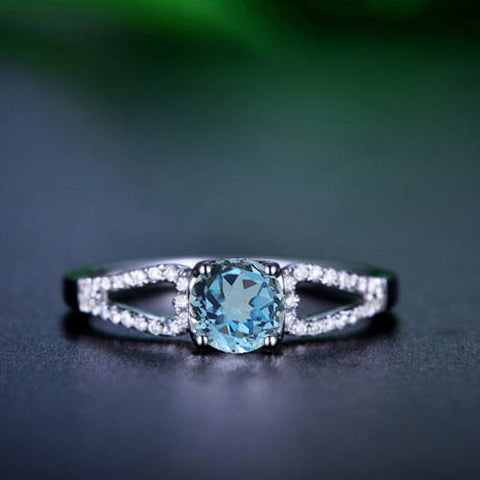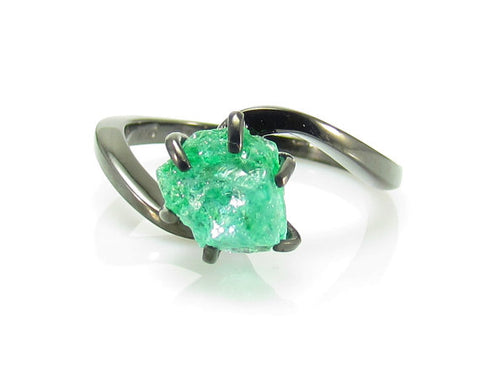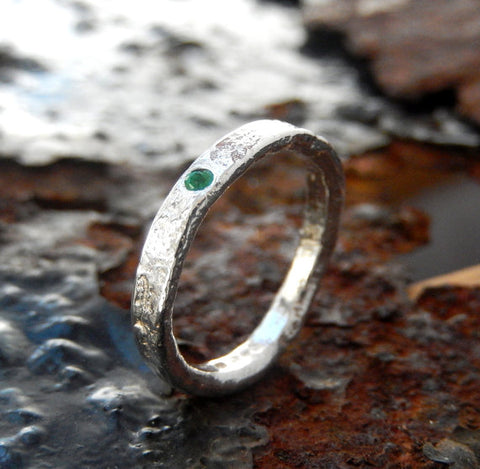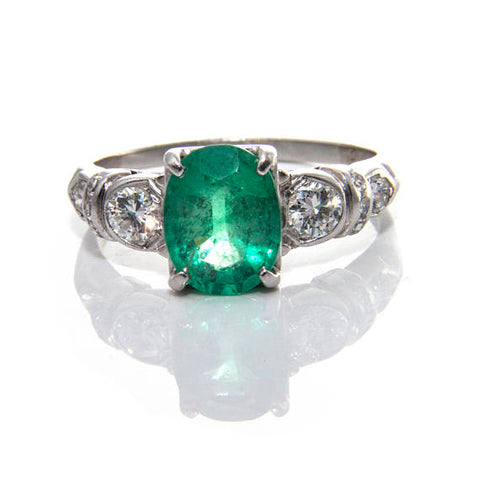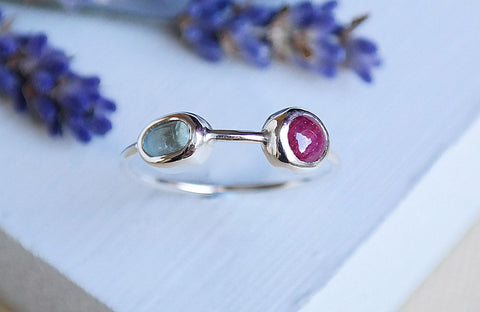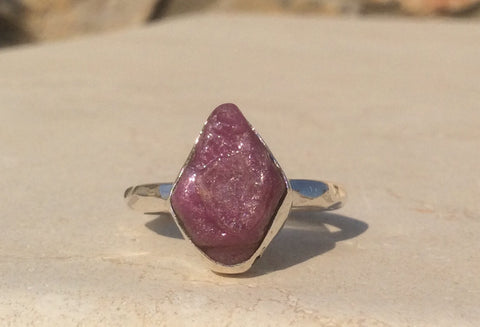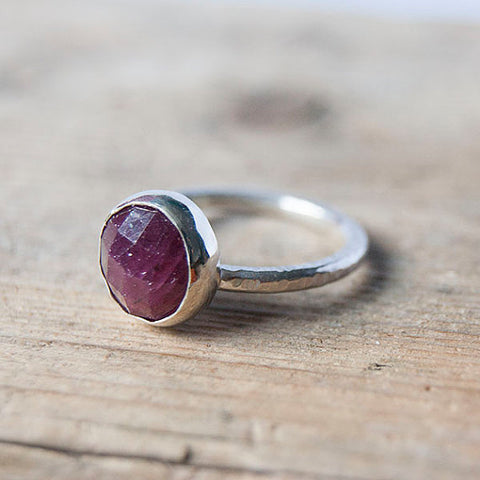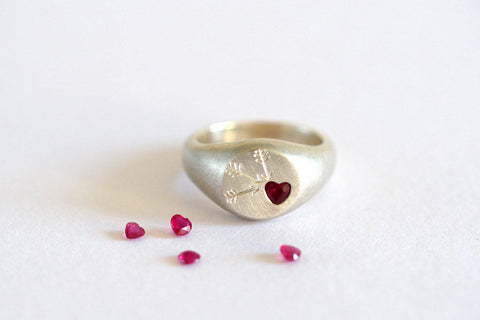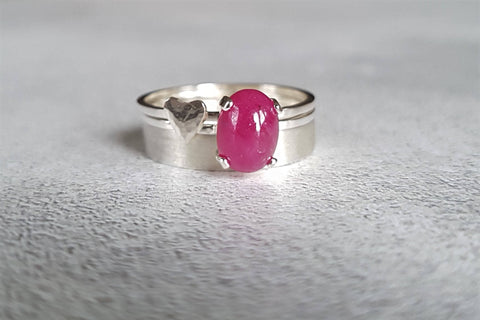Topaz makes for an ideal gemstone ring. The gem embodies certain properties which make it a desirable stone, it comes in a range of sought after colours, it’s good hardness means it’s not easily scratched or damaged, and it’s relative abundance and accessibility ensure it continues to be one of the most popular gemstones. Topaz rings are a staple of the jewellery market and are ever increasing in popularity.
Imperial Topaz which is characterised by its golden yellow colours is the most valuable colour of Topaz, followed closely by stones with a dark pink/red and orange/red hue. He inherit value of the stone increases in proportion to the deepness of the orange and reddish coloured hues. However, the most common colour used in jewellery today is the blue topaz. Blue topaz is a relatively recent occurrence, which is chiefly due to the fact the nearly all blue gem topaz is formed by being irradiated and heat treated.
Natural Topaz Rings

Topaz is an abundant and cost effective gemstone. It is often found formed into very large and flawless crystals. These giant gemstones can be cut into giant gemstones and are capable of weighing thousands of carats. Due to this, some of largest gemstones which have every been created and used in jeweller were made of Topaz.
Topaz is an innately hard and robust gemstone, and is not easily damaged or dissolved in solvent solutions. However, it’s still important to be careful with Topaz, it is possible to chip or cracking internally if exposed to significant trauma. Topaz is described as a pleochroic gemstone, which essentially means it’s capable of showing a range of colour intensities and hues depending on the angle the gem is viewed from.
Despite its common use in jewellery, natural blue topaz is rare and it’s almost always very faintly coloured. Most blue topaz you’re likely to encounter has been irradiated and heat treated in order to create the blue hue. Before being treated, the original stones where likely colourless or very lightly coloured, the radiation process will then work to deepen and emphasis the blue hue and lastly the heat treatment works to stabilise the colourisation.
Topaz History
It is widely agreed that the name for Topaz originated from Topazios, which is the old Greek name for an island located in the Red Sea, which is now called Zabargad. The island actually never produced Topaz, but it was a producer of peridot. It’s likely that the peridot was confused with topaz, which is something that has been rectified with modern mineralogy methods.
The ancient Greeks thought that Topaz would give them power and strength. During the Renaissance period in Europe, it was commonly believed that topaz had the power to prevent and break magical spells, as well as having the ability to dissipate anger. For hundreds of years, it has believed by many people in India that when topaz is worn above the heart, it can assure a long life, intelligence and promote beauty in the wearer.
Imperial Topaz originated in 19th century Russia. During this time, the Ural mountain range were the leading source for topaz, and the uniquely pink gemstones mined in the mountains were named to honour the Russian czar. To ensure its exclusivity, ownership of the pink gemstones was restricted to only the royal family.
Topaz Engagement & Wedding Rings
Topaz engagements are defined by the beautifully eye catching and hardy gemstone at the centre of the design, topaz is a perfect choice for an everyday wear wedding ring. With the huge variety of options available, it’s completely understandable to feel overwhelmed by the choice and options available. This short guide will hopefully make your decision easier and allow you to pick the perfect ring.
On paper topaz is the perfect gemstone, it’s durable, stunning, flashy and very affordable. Additionally, topaz is easily shaped and cut to match almost any desired option, including emerald, pear, heart, cushion and round.
Topaz is a type of silicate crystal mineral, and has been a popular engagement and wedding ring for a number of years. Most topaz rings sold today have been enhanced in some way in order to emphasise the vibrancy of the colours, which is not necessarily a bad thing. Topas is mined in a number of countries including, Brazeil, Afghanistan, Germany, India, Russia and the United States to name but a few of the topaz producing countries.
Blue Topaz Engagement Rings
Most of the blue topaz found in today’s engagement rings started life as a colourless stone, this stone is then irradiated and heat treated to produce the stunning range of blue shades which are now commonly associated with blue topaz engagement rings. The sort of treatment is very common occurrence and only serves to enhance the appearance of the gemstone, the resulting colour is very stable and no special care or attention needs to be paid to the ring in order to maintain the colour.
A blue topaz engagement ring is very affordable, with prices ranging from around £8 per carat through to £40 per carat. Some of the hues of blue are inherently worth more than others, normally darker colours such as ‘Swiss Blue’, ‘London Blue’ and ‘Sierra Blue’ will cost more than a lighter variant.
London blue topaz rings are characterised by their deep almost teal colouring, and are one of the more costly types of Topaz available.
A large portion of the intrinsic value of a blue topaz gemstone is not in the raw stone, it’s in the labour that goes into shaping and cutting the stone into the desired shape. As such, a commercially massed produced cut stone can be bought for as little as £30, however a custom designed and cut stone may sell for more than £200.
As most topaz is naturally clear, high clarity does not significantly impact the price of a stone. However, any visible inclusions or faults can significantly reduce the price of the stone.
Unlike many other gemstones, the price per carat does not exponentially increase as the size of the stone increases. For example, a five carat blue topaz engagement ring might not cost significantly more than a one carat blue engagement ring.
It’s no unusual for the rings metal or any accompanying gems, such as diamonds, to have the biggest impact on the final cost of the ring. As such, choosing a sterling silver blue topaz engagement ring might be the perfect choice if you’re looking to keep costs down.
Imperial Topaz Engagement Rings
Like blue topaz, almost all imperial topaz on today’s market has been treated to enhance the natural colourisation of the stone. Most of the gems would have originally been faintly coloured, which has then been irradiated and heat treated to produce a some impressively intense oranges, reds and pink colours.
A pink topaz engagement ring will cost around £30 per carat, but unlike their blue counterparts, the price per carat can increase significantly once the carat weight goes above 5 carats. Intensely bright pinks will often sell for more than £30 per carat.
Naturally pink topaz which has not been treated will sell for many thousands of pounds per carat, making them some of the most expensive gemstones available. It’s worth noting that some jewellers will sell competitively priced ‘natural pink topaz’, this is actually slightly misleading, as they are still treated to achieve the colour. All topaz, even enhanced versions are still classed as natural gemstones.
Precious Topaz Engagement Rings
Precious topaz is used to describe the bright almost luminous yellow or orange gemstones.
As with every other type of topaz, the incredible yellow hues and orange colours are created by exposing the gemstones to radiation and heat treatment. This treatment has very good stability and are very unlikely to fad over time.
Yellow or orange engagement rings will usually be priced at around £20 per carat for anything underneath 5 carats, this will increase to around £60 per carat for gems over 5 carats. If a topaz has an especially vibrant and intense yellow or orange hue then the cost of the gemstone can increase dramatically. Custom cuts and designs will invariably demand a higher price tag.
Mystic Topaz Engagement Rings
Mystic topaz engagement rings are exemplified by their ability to reflect a rainbow of colours, this can range from dark peacock colouring through to light rainbow effect. Mystic topaz was developed in late 1998, but it was not until 2003 that the colour began to gain traction in the jewellery world. Today the gem is very popular, but thankfully the price remains affordable.
Just like every other topaz variety described here, mystic topaz begins life as a colourless stone. There are varying treatments available to create the mystic effect, however, only the diffusion method has been demonstrated to be effective at holding the colouring for a long period of time.
Brown Topaz Engagement Ring
Topaz frequently occurs in natural brown hues, or can be altered via irradiation and heat treatment. Despite the connotations associated with the colour, some Topaz with brown colourings can be quite beautiful. However, there are some issues these stones in particular. They have a tendency to fade once exposed to direct sunlight, so for this reason we cannot recommend the stone colour for use in a engagement or wedding ring.
Green Topaz Engagement Ring
Most green topaz available on the market have been treated in order to create the colouring and vibrant green colour.
Unfortunately, the stability of the colour in green topaz is largely unstable. Most green gemstones have been shown to fade over time, the fading process is also accelerated by exposure to sunlight. For this reason it’s hard to recommend green topaz for an engagement or wedding ring. However, work is underway to improve the stability rating of green topaz, so we’d hope to be able to change our opinion very soon.
Colourless Topaz Engagement Ring
Colourless topaz is the most common natural form of Topaz that is frequently mined. A clear, brilliant and beautiful colourless topaz ring is a great way to exhibit the stones innate splendour and fire.
Colourless topaz or white topaz is a very affordable option, with prices starting at around $5 per carat. This price point remains largely stable regardless of the carat weight of the stone.
A white topaz engagement ring is one of our first choices for a diamond ring alternative, these gems are very beautiful and can substitute a diamond wedding or engagement ring easily.
Caring for a Topaz Ring
Topaz is generally regarded as a long-lasting, resilient and hard gemstone, which is one of the reasons it makes for such a good every day ring. However, even though the gem is hard, it can still become dirty and require some minor maintenance to ensure it looks its best. The simplest and one of the most effective methods for cleaning a Topaz ring involves soap and water. Simply place a small amount of warm water in a bowl, add a few drops of mild soap and the ring soak for a couple of minutes. Using a soft bristle brush or cloth, work your way around the ring and try and get into all the nooks and crannies to remove any built up dirt. Once cleaned rinse the ring with fresh water to remove any soapy residue, pat the ring dry and leave to one side to dry in a well ventilated location away from direct sunlight. If you can, avoid doing all of this over the kitchen sink, the last thing you want to do is accidentally knock the topaz out of its setting and watch it disappear down the sink hole.
If you have access to a ultrasonic cleaner or a steam cleaner, you should have no problems using this with your topaz ring. However, as with all advanced cleaning methods, it’s recommended to thoroughly read and understand the instructions before starting the cleaning process.
It might seem obvious, but if you’re going to handling harsh chemicals, carrying out DIY or working extensively with your hands, it would probably be a good idea to remove the ring until you’ve finished these tasks. Even though the gemstone will remain intact, you don’t want to damage the rings settings.
As Topaz is a relatively hard gemstone, you’ll need to be careful when wearing the ring with other less sturdy gems. For example, both pearls and opals can be easily scratched and damaged by another adjacent gemstone ring. So just be wary of what you’re wearing with your Topaz ring.
from
https://www.mypearls.co.uk/blogs/news/12-outstanding-examples-of-a-topaz-ring









